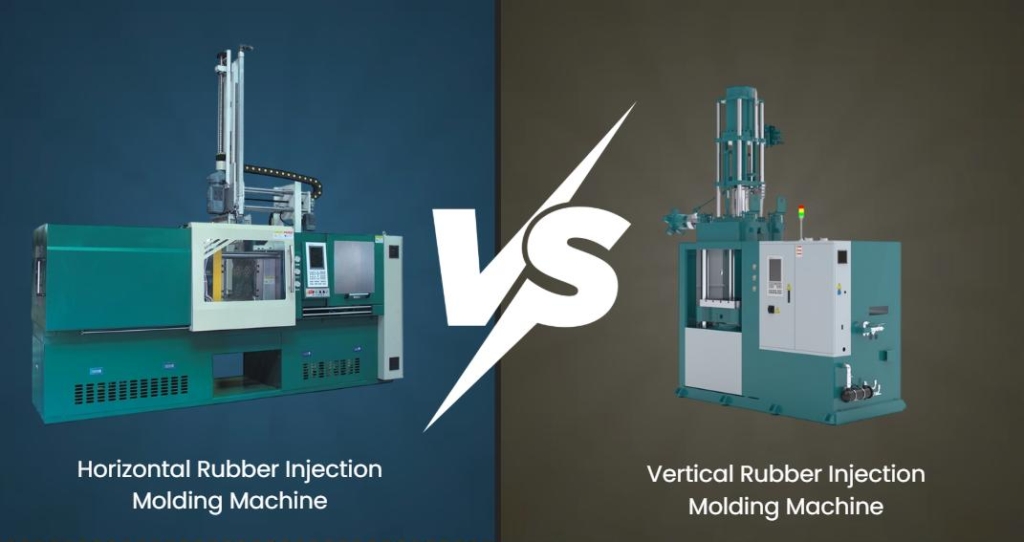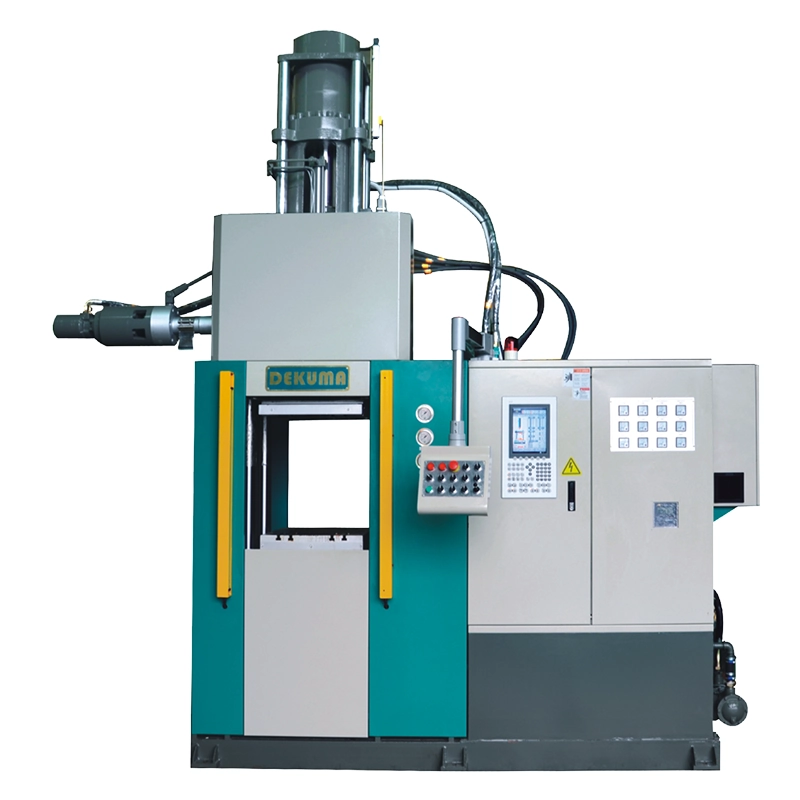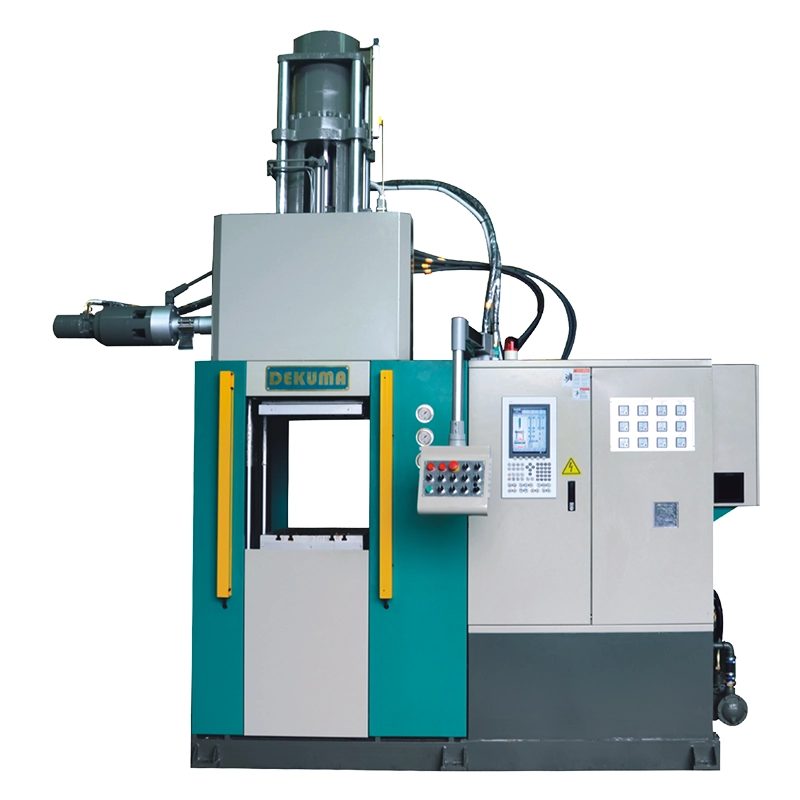Rubber injection molding machines are essential to modern automotive manufacturing, producing precise seals, gaskets, boots, and bushings at high volume. Yet manufacturers face an important choice before production even begins: horizontal or vertical orientation.
Vertical presses excel when over-molding inserts or saving floor space, while horizontal machines integrate easily with automated conveyor lines.
This article explores both options, outlining key performance factors and application scenarios to help automotive engineers and sourcing teams select the right machine for their specific requirements.

Table of Contents
ToggleVertical and Horizontal Rubber Injection Molding Machines
Vertical Machines
Vertical presses clamp and open in a vertical plane, with the injection unit positioned above the mold. This design offers several benefits:
- Easy insert loading: Gravity helps hold inserts in place, and therefore, operators or robots can place metal, electronics, or components with less fuss.
- Precision for complex shapes: Ideal for over-mold jobs and small parts that demand tight dimensional control.
- Compact footprint: Works well in cells where floor space is limited.
Despite these advantages, they are not the best choice for long continuous profiles or extended production runs, where horizontal machines outperform them.
Horizontal Machines
Horizontal presses feature a side-opening mold orientation, allowing parts to eject sideways and drop directly onto conveyors. Key advantages include:
- High throughput: Short cycle times and compatibility with multi-cavity molds make them excellent for high-volume production.
- Automation–friendly: Integrates seamlessly with conveyor systems and robotic handling.
- Suited for long parts: Handles lengthy components and continuous runs efficiently.
However, loading and aligning inserts is more challenging for horizontal rubber injection molding machines, so intricate insert-molding jobs may require a vertical press.
Automotive Applications and Machine Recommendations
Automotive Glass Seals / Edge Seals
√ Recommended machine: vertical injection molding
Vertical presses are ideal for automotive glass seals and edge seals because they can securely hold both the glass and any embedded inserts, ensuring precise alignment throughout the molding process.
Rotary tables allow operators to load parts on one side while molding occurs on the other, improving efficiency and enabling consistent handling of curved edges and clips. These seals should meet strict requirements for waterproofing, dustproofing, and noise reduction, and vertical machines help achieve this by stabilizing inserts and providing tight dimensional control.
This combination of precision and efficiency makes vertical injection molding the preferred choice for glass encapsulation.
Door Seals & Gaskets
√ Recommended machine: horizontal injection molding
Horizontal presses are ideal for long, continuous parts like door seals and gaskets. Their design pairs with automation for fast and repeatable cycles that maintain consistent dimensions across large production runs. Most full-length door seals are made from extruded EPDM, and horizontal cells efficiently mold corners and joints with uniform quality.
Such precision in molding allows the door seals to consistently fulfill their functional roles in sealing, soundproofing, and dampening vibrations.
Hood & Trunk Seals
√ Recommended machine: Depends on part geometry and material
Long, straight sections or multi-cavity parts are efficiently molded on horizontal machines, using materials like TPE/TPV to resist heat and ozone.
Complex corners, clips, or over-molded features are better handled by vertical presses, which work well with LSR for extreme temperature fluctuations.
Other Rubber Components (Anti-vibration Pads, Protective Sleeves, etc.)
For metal-rubber mounts or overmolded sleeves, vertical injection molding machines excel. Their design leverages gravity to hold inserts securely in place, and features like turntables streamline loading and unloading.
On the other hand, for high-volume parts such as boots, grommets, and pads, horizontal injection molding machines are the better choice. Their layout supports automation, increasing throughput and ensuring consistent part-to-part quality across large production runs.
How to Choose an Automotive Rubber Injection Molding Machine?
Part Shape and Size
Complex or insert-heavy parts suit vertical presses, as gravity holds inserts in place and rotary tables allow simultaneous loading and molding. Long or large parts often work better on horizontal machines, which handle bigger tools and provide easier side access.
Production Volume and Efficiency
For high output, horizontal presses perform better with faster cycles and multiple cavities. Vertical machines with shuttle or rotary tables can improve throughput and save floor space, but are generally better for moderate volumes.
Rubber Material Type (EPDM, LSR, TPV, etc.)
LSR flows well with precise heat and vacuum, ideal for thin seals. EPDM resists water and UV for outdoor applications. TPV molds like plastic and can be tuned for NVH performance. Both machine types handle these materials, but LSR needs careful gating and venting.
Performance Requirements (Waterproofing, Noise Reduction, Durability)
Functional performance depends on machine precision. Stable clamping, accurate temperature control, and proper venting or vacuum ensure waterproof LSR, noise-reducing TPV, and durable EPDM parts, regardless of vertical or horizontal orientation.
Dekuma Vertical Rubber Injection Molding Machine for Automotive Parts Manufacturing
If you need to produce automotive rubber parts with inserts or complex geometries, vertical injection molding machines provide precise positioning and efficient multi-step operations. Dekuma, a trusted provider of precision rubber injection solutions, offers the RV Series Rubber Injection Molding Machine, robust enough to manufacture automotive-grade rubber compounds.
Key advantages of this vertical rubber injection molding machine include:
√ Optimized for Automotive Materials
Supports EPDM, TPV, and other high-performance automotive rubber compounds. The advanced plasticization and injection system delivers consistent quality for seals, mounts, and vibration-damping components.
√ Precision Stroke Control
Features an electronic ruler with ±0.05% accuracy, ensuring exact injection and clamping strokes. This maintains strict dimensional tolerances and reliable performance in automotive parts.
√ High-Efficiency Injection
The accumulator is designed for rapid disassembly, and material removal is simple, minimizing downtime and keeping high-volume production lines running smoothly.
√ Stable, High-Performance Operation
German-standard insulation plates and robust hydraulics ensure the machine maintains reliability and consistent output even under high pressure and temperature conditions common in automotive production.

In automotive rubber parts production, vertical machines are ideal for complex, insert-heavy components, while horizontal machines suit high-volume runs with consistent quality. The best choice depends on your part design, production scale, and performance requirements. If you want reliable, precise, and efficient results, exploring machines from Dekuma can help you achieve your manufacturing goals with confidence.




